Abstract
Sera of 22 patients with active and 13 with inactive coccidioidomycosis, as well as 15 healthy subjects who were skin-test positive to coccidioidin and 39 healthy subjects who were coccidioidin skin-test negative, were assayed for immune complexes. Circulating immune complexes were measured by the Clq-binding assay, the Clq-solid phase assay, the monoclonal rheumatoid factor inhibition assay, and the monoclonal rheumatoid factor solid phase assay. An increased concentration of circulating immune complexes was detected in 73% of those with active disease by at least one assay compared with 13% of the healthy controls. Significantly increased levels of immune complexes were detected in sera of patients with active coccidioidomycosis by the Clq-binding assay (P < 0.001), the Clq-solid phase assay (P < 0.001), the monoclonal rheumatoid factor inhibition assay (P < 0.005), and the monoclonal rheumatoid solid phase assay (P < 0.05) compared with the results obtained in the 54 healthy subjects. In contrast, those with inactive disease did not show significantly increased concentrations of circulating immune complexes. Sucrose density gradient ultracentrifugation of patients' sera established that the immune complexes were of intermediate size, sedimenting between the 6.6S and 19S markers. Immune complexes were shown to contain both coccidioidin antigen and anticoccidioidin antibody. In addition, a radioimmunoassay was developed to quantitate coccidioidin antigen-containing immune complexes. The latter assay proved highly sensitive in detecting immune complexes in patients with active coccidioidomycosis.
Full text
PDF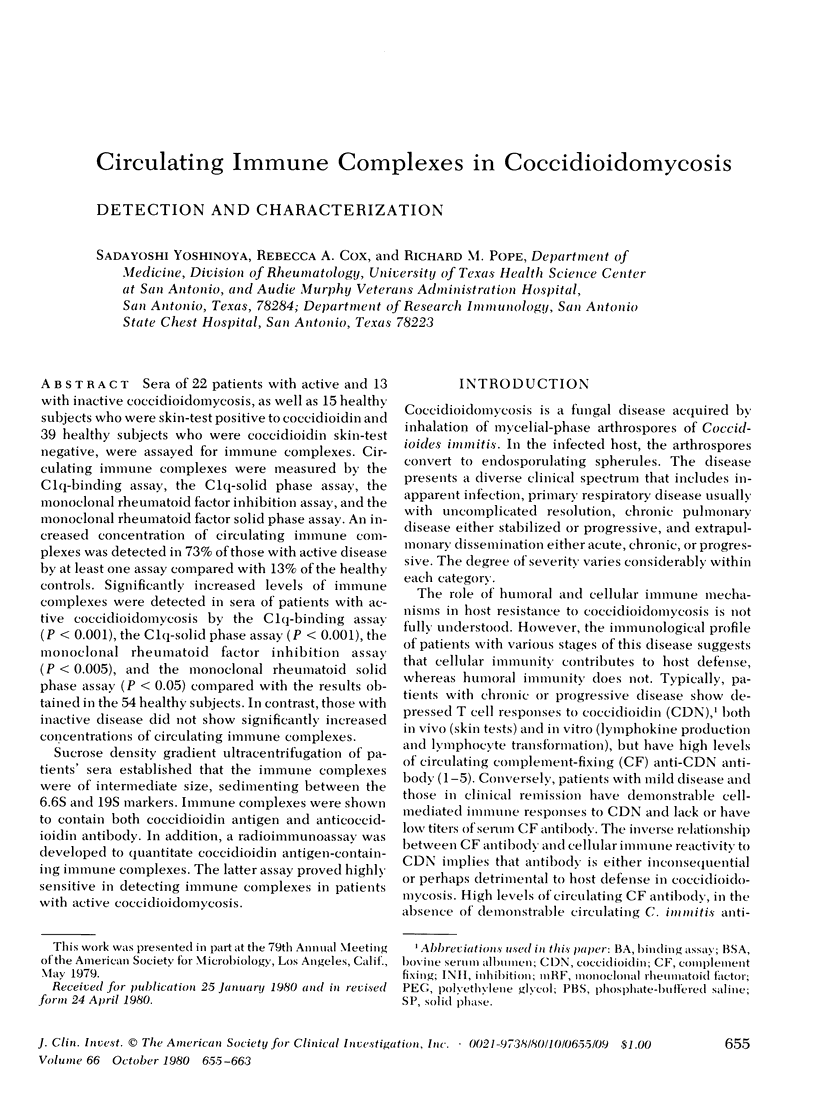
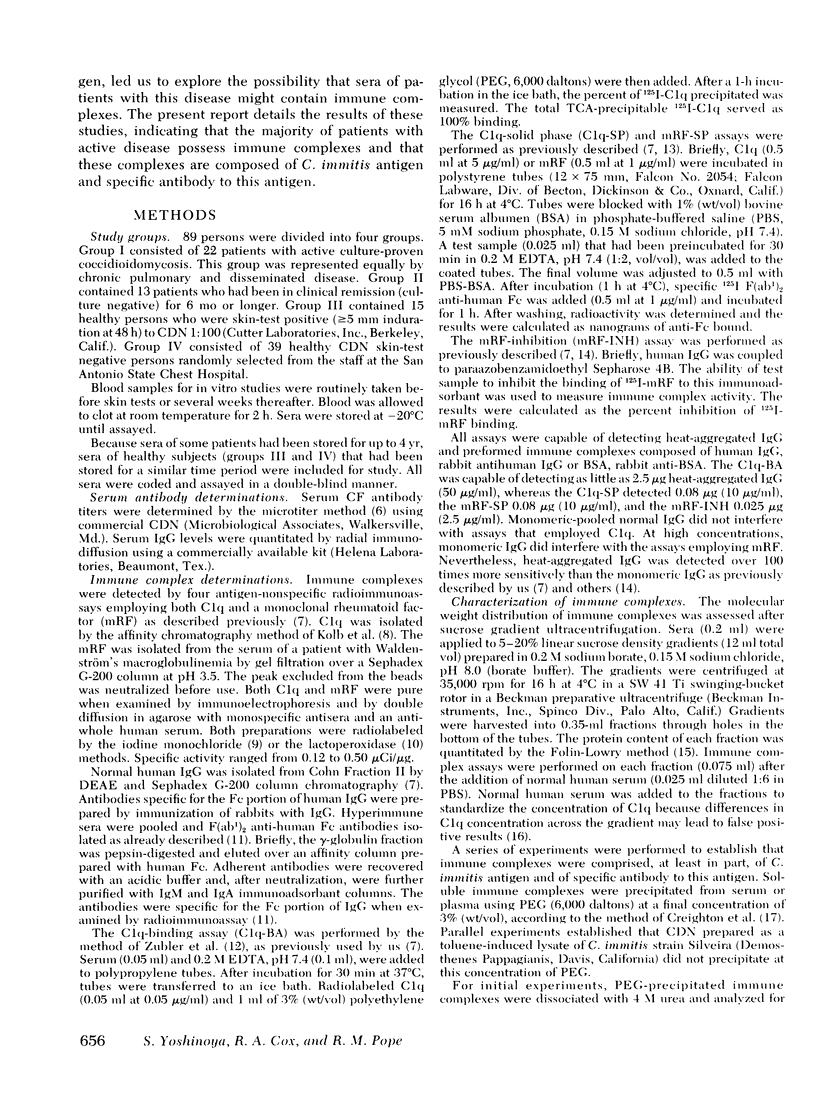

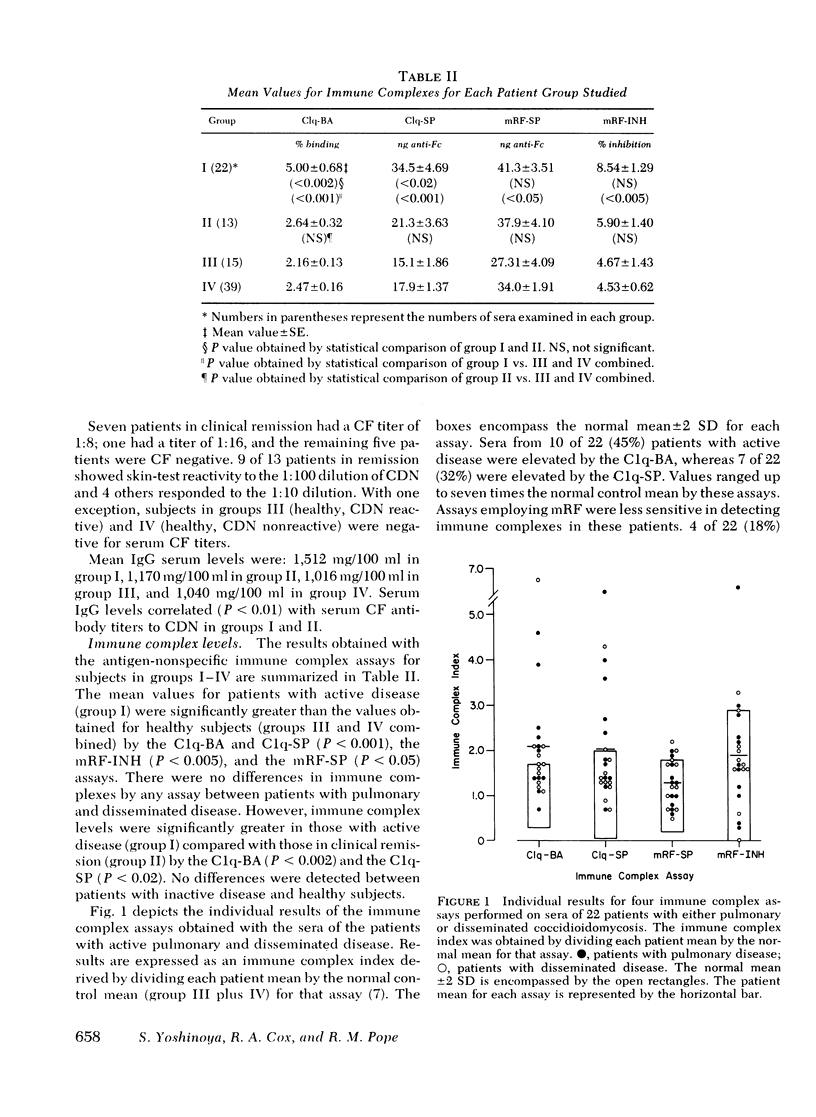
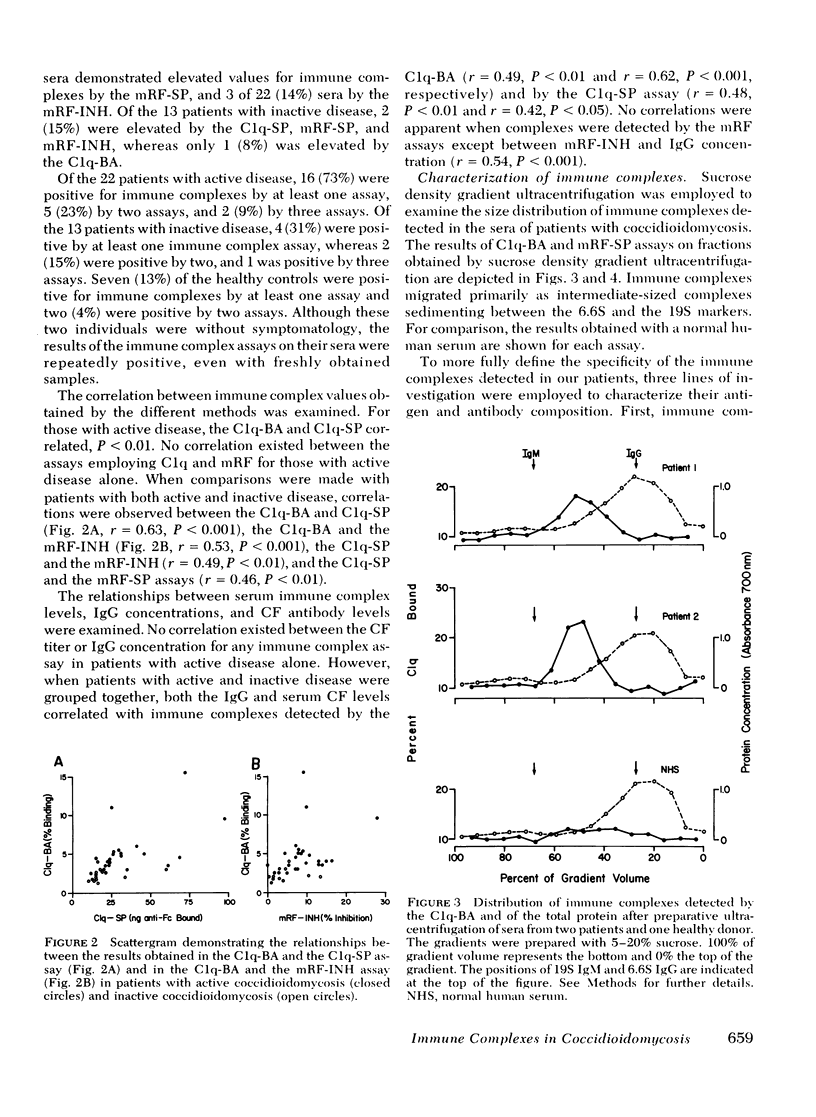
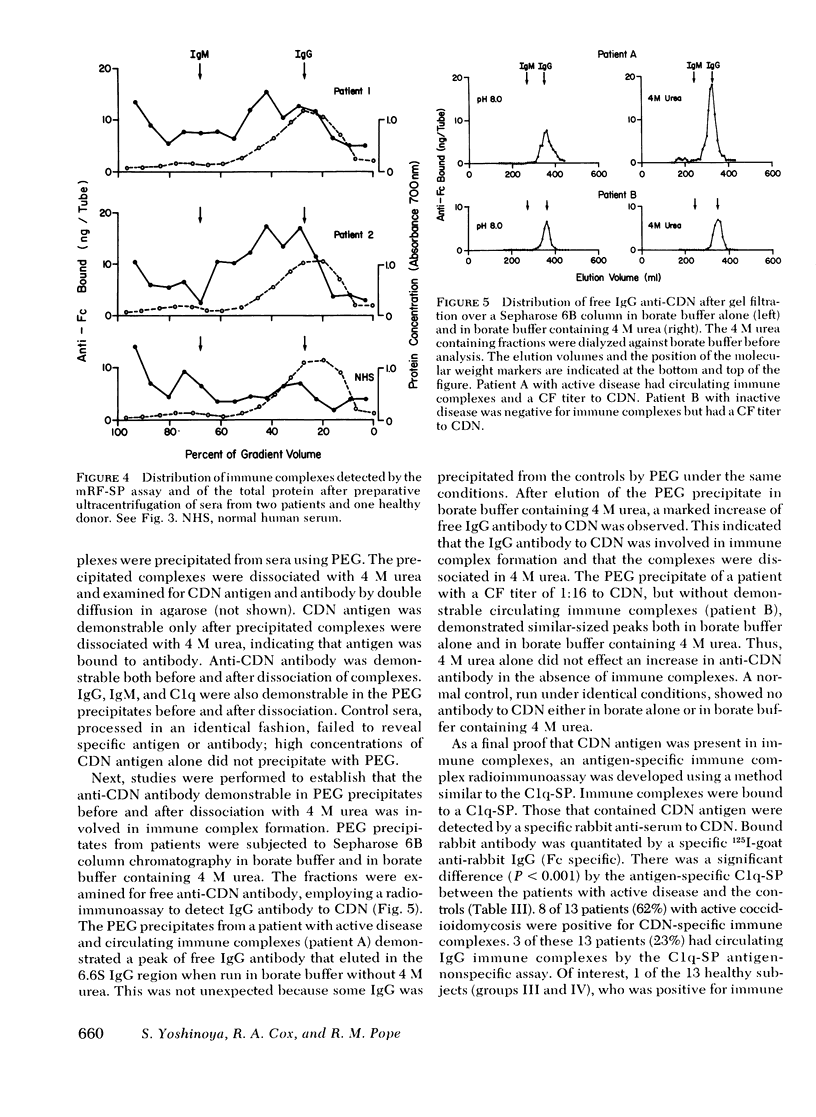
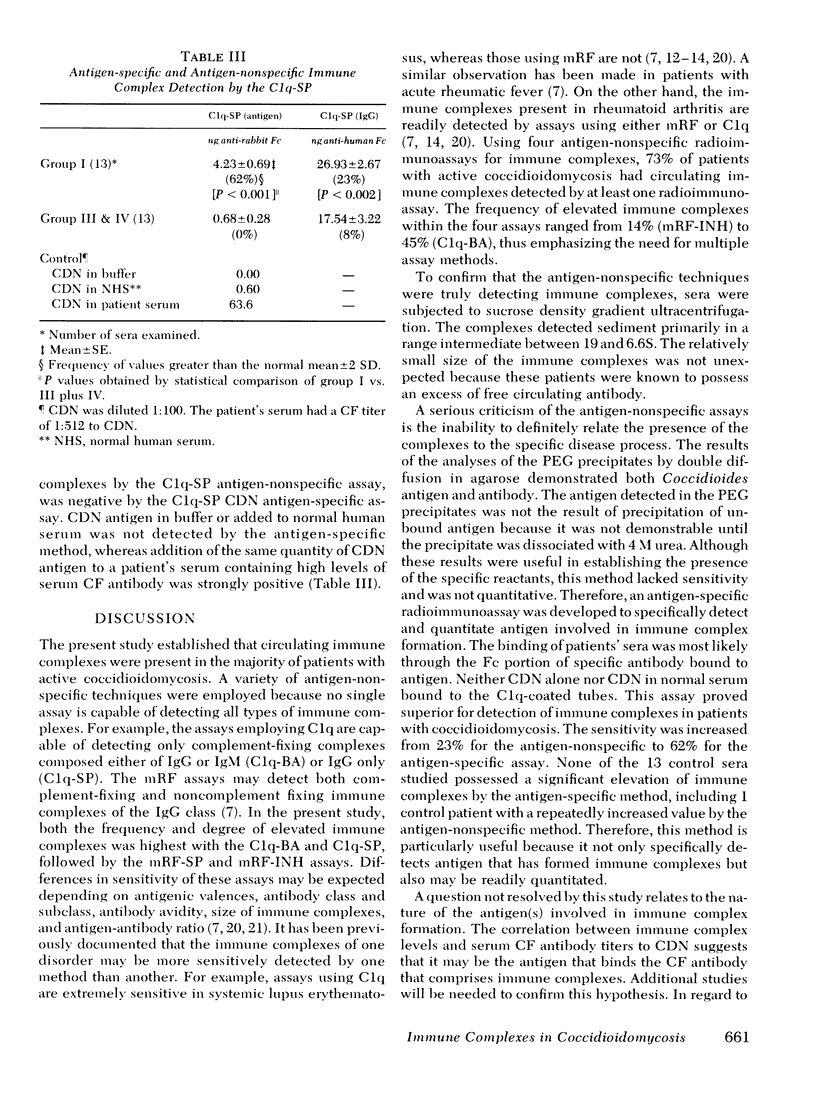
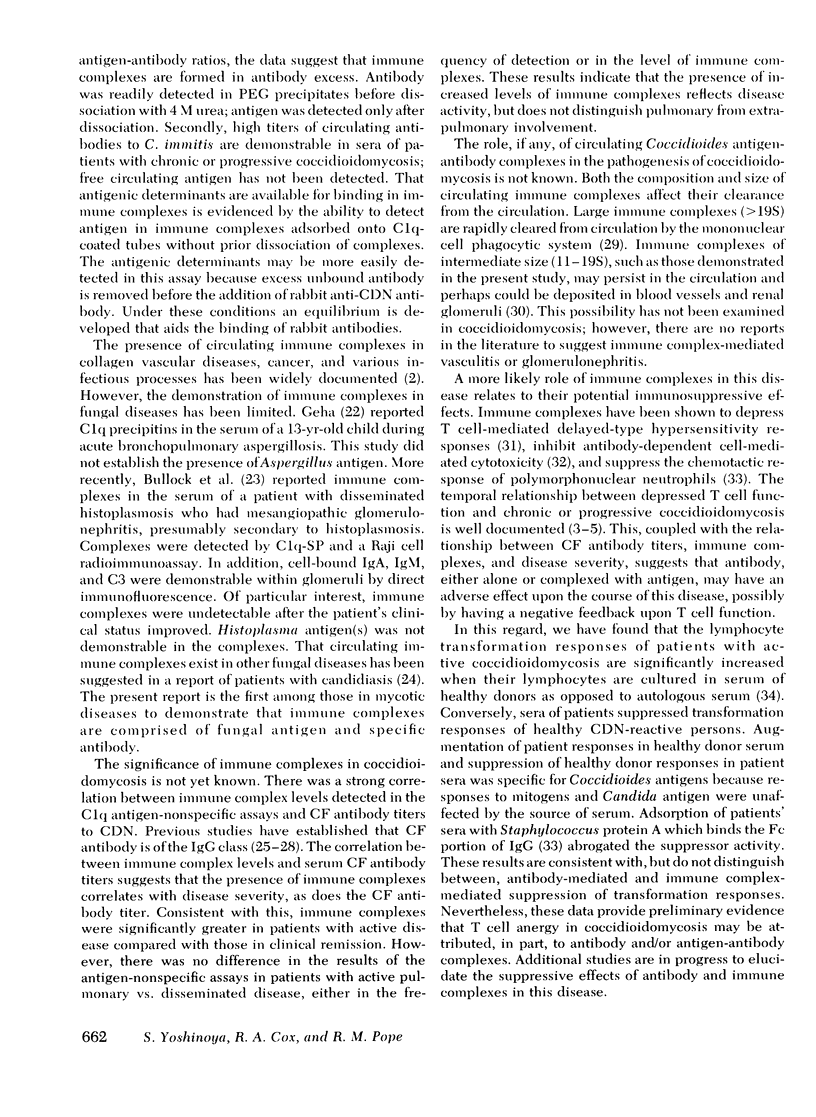
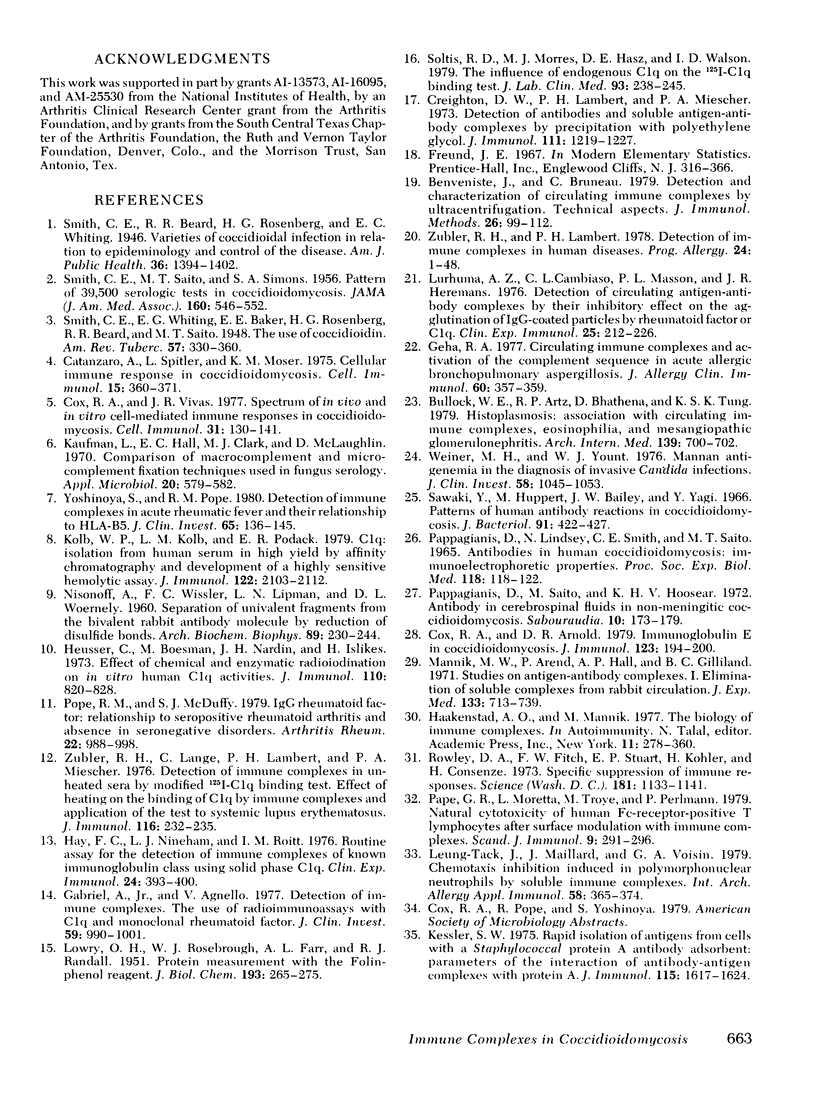
Selected References
These references are in PubMed. This may not be the complete list of references from this article.
- Benveniste J., Bruneau C. Detection and characterization of circulating immune complexes by ultracentrifugation. Technical aspects. J Immunol Methods. 1979;26(2):99–112. doi: 10.1016/0022-1759(79)90074-7. [DOI] [PubMed] [Google Scholar]
- Bullock W. E., Artz R. P., Bhathena D., Tung K. S. Histoplasmosis. Association with circulating immune complexes, eosinophilia, and mesangiopathic glomerulonephritis. Arch Intern Med. 1979 Jun;139(6):700–702. doi: 10.1001/archinte.139.6.700. [DOI] [PubMed] [Google Scholar]
- Catanzaro A., Spitler L. E., Moser K. M. Cellular immune response in coccidioidomycosis. Cell Immunol. 1975 Feb;15(2):360–371. doi: 10.1016/0008-8749(75)90014-3. [DOI] [PubMed] [Google Scholar]
- Cox R. A., Arnold D. R. Immunoglobulin E in coccidioidomycosis. J Immunol. 1979 Jul;123(1):194–200. [PubMed] [Google Scholar]
- Cox R. A., Vivas J. R. Spectrum of in vivo and in vitro cell-mediated immune responses in coccidioidomycosis. Cell Immunol. 1977 Jun 1;31(1):130–141. doi: 10.1016/0008-8749(77)90012-0. [DOI] [PubMed] [Google Scholar]
- Creighton W. D., Lambert P. H., Miescher P. A. Detection of antibodies and soluble antigen-antibody complexes by precipitation with polyethylene glycol. J Immunol. 1973 Oct;111(4):1219–1227. [PubMed] [Google Scholar]
- Gabriel A., Jr, Agnello V. Detection of immune complexes. The use of radioimmunoassays with Clq and monoclonal rheumatoid factor. J Clin Invest. 1977 May;59(5):990–1001. doi: 10.1172/JCI108722. [DOI] [PMC free article] [PubMed] [Google Scholar]
- Geha R. S. Circulating immune complexes and activation of the complement sequence in acute allergic bronchopulmonary aspergillosis. J Allergy Clin Immunol. 1977 Dec;60(6):357–359. doi: 10.1016/0091-6749(77)90066-5. [DOI] [PubMed] [Google Scholar]
- Hay F. C., Nineham L. J., Roitt I. M. Routine assay for the detection of immune complexes of known immunoglobulin class using solid phase C1q. Clin Exp Immunol. 1976 Jun;24(3):396–400. [PMC free article] [PubMed] [Google Scholar]
- Heusser C., Boesman M., Nordin J. H., Isliker H. Effect of chemical and enzymatic radioiodination on in vitro human Clq activities. J Immunol. 1973 Mar;110(3):820–828. [PubMed] [Google Scholar]
- Kaufman L., Hall E. C., Clark M. J., McLaughlin D. Comparison of macrocomplement and microcomplement fixation techniques used in fungus serology. Appl Microbiol. 1970 Oct;20(4):579–582. doi: 10.1128/am.20.4.579-582.1970. [DOI] [PMC free article] [PubMed] [Google Scholar]
- Kessler S. W. Rapid isolation of antigens from cells with a staphylococcal protein A-antibody adsorbent: parameters of the interaction of antibody-antigen complexes with protein A. J Immunol. 1975 Dec;115(6):1617–1624. [PubMed] [Google Scholar]
- Kolb W. P., Kolb L. M., Podack E. R. C1q: isolation from human serum in high yield by affinity chromatography and development of a highly sensitive hemolytic assay. J Immunol. 1979 May;122(5):2103–2111. [PubMed] [Google Scholar]
- LOWRY O. H., ROSEBROUGH N. J., FARR A. L., RANDALL R. J. Protein measurement with the Folin phenol reagent. J Biol Chem. 1951 Nov;193(1):265–275. [PubMed] [Google Scholar]
- Lurhuma A. Z., Cambiaso C. L., Masson P. L., Heremans J. F. Detection of circulating antigen-antibody complexes by their inhibitory effect on the agglutination of IgG-coated particles by rheumatioid factor of Clq. Clin Exp Immunol. 1976 Aug;25(2):212–226. [PMC free article] [PubMed] [Google Scholar]
- Mannik M., Arend M. P., Hall A. P., Gilliland B. C. Studies on antigen-antibody complexes. I. Elimination of soluble complexes from rabbit circulation. J Exp Med. 1971 Apr 1;133(4):713–739. doi: 10.1084/jem.133.4.713. [DOI] [PMC free article] [PubMed] [Google Scholar]
- NISONOFF A., WISSLER F. C., LIPMAN L. N., WOERNLEY D. L. Separation of univalent fragments from the bivalent rabbit antibody molecule by reduction of disulfide bonds. Arch Biochem Biophys. 1960 Aug;89:230–244. doi: 10.1016/0003-9861(60)90049-7. [DOI] [PubMed] [Google Scholar]
- PAPPAGIANIS D., LINDSEY N. J., SMITH C. E., SAITO M. T. ANTIBODIES IN HUMAN COCCIDIOIDOMYCOSIS: IMMUNOELECTROPHORETIC PROPERTIES. Proc Soc Exp Biol Med. 1965 Jan;118:118–122. doi: 10.3181/00379727-118-29773. [DOI] [PubMed] [Google Scholar]
- Pappagianis D., Saito M., Van Hoosear K. H. Antibody in cerebrospinal fluid in non-meningitic coccidioidomycosis. Sabouraudia. 1972 Jul;10(2):173–179. doi: 10.1080/00362177285190341. [DOI] [PubMed] [Google Scholar]
- Pope R. M., McDuffy S. J. IgG rheumatoid factor. Relationship to seropositive rheumatoid arthritis and absence in seronegative disorders. Arthritis Rheum. 1979 Sep;22(9):988–998. doi: 10.1002/art.1780220907. [DOI] [PubMed] [Google Scholar]
- Rowley D. A., Fitch F. W., Stuart F. P., Köhler H., Cosenza H. Specific suppression of immune responses. Science. 1973 Sep 21;181(4105):1133–1141. doi: 10.1126/science.181.4105.1133. [DOI] [PubMed] [Google Scholar]
- SMITH C. E., SAITO M. T., SIMONS S. A. Pattern of 39,500 serologic tests in coccidioidomycosis. J Am Med Assoc. 1956 Feb 18;160(7):546–552. doi: 10.1001/jama.1956.02960420026008. [DOI] [PubMed] [Google Scholar]
- Sawaki Y., Huppert M., Bailey J. W., Yagi Y. Patterns of human antibody reactions in coccidioidomycosis. J Bacteriol. 1966 Jan;91(1):422–427. doi: 10.1128/jb.91.1.422-427.1966. [DOI] [PMC free article] [PubMed] [Google Scholar]
- Soltis R. D., Morris M. J., Hasz D. E., Wilson I. D. The influence of endogenous serum C1q on the 125I-C1q binding test. J Lab Clin Med. 1979 Feb;93(2):238–245. [PubMed] [Google Scholar]
- Weiner M. H., Yount W. J. Mannan antigenemia in the diagnosis of invasive Candida infections. J Clin Invest. 1976 Nov;58(5):1045–1053. doi: 10.1172/JCI108555. [DOI] [PMC free article] [PubMed] [Google Scholar]
- Yoshinoya S., Pope R. M. Detection of immune complexes in acute rheumatic fever and their relationship to HLA-B5. J Clin Invest. 1980 Jan;65(1):136–145. doi: 10.1172/JCI109643. [DOI] [PMC free article] [PubMed] [Google Scholar]
- Zubler R. H., Lambert P. H. Detection of immune complexes in human diseases. Prog Allergy. 1978;24:1–48. [PubMed] [Google Scholar]
- Zubler R. H., Lange G., Lambert P. H., Miescher P. A. Detection of immune complexes in unheated sera by modified 125I-Clq binding test. Effect of heating on the binding of Clq by immune complexes and application of the test to systemic lupus erythematosus. J Immunol. 1976 Jan;116(1):232–235. [PubMed] [Google Scholar]


